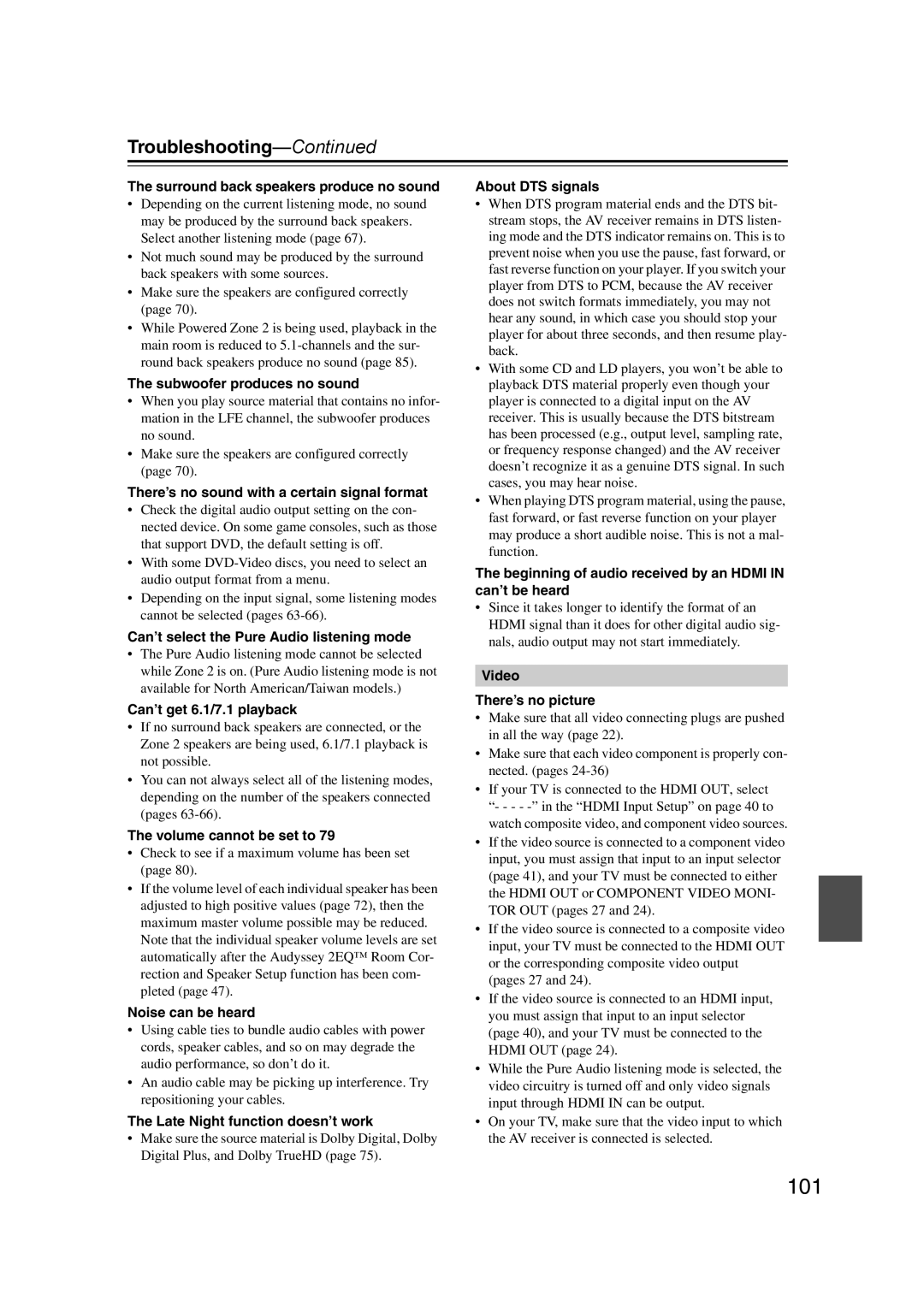
Troubleshooting—Continued
The surround back speakers produce no sound
•Depending on the current listening mode, no sound may be produced by the surround back speakers. Select another listening mode (page 67).
•Not much sound may be produced by the surround back speakers with some sources.
•Make sure the speakers are configured correctly (page 70).
•While Powered Zone 2 is being used, playback in the main room is reduced to
The subwoofer produces no sound
•When you play source material that contains no infor- mation in the LFE channel, the subwoofer produces no sound.
•Make sure the speakers are configured correctly (page 70).
There’s no sound with a certain signal format
•Check the digital audio output setting on the con- nected device. On some game consoles, such as those that support DVD, the default setting is off.
•With some
•Depending on the input signal, some listening modes cannot be selected (pages
Can’t select the Pure Audio listening mode
•The Pure Audio listening mode cannot be selected while Zone 2 is on. (Pure Audio listening mode is not available for North American/Taiwan models.)
Can’t get 6.1/7.1 playback
•If no surround back speakers are connected, or the Zone 2 speakers are being used, 6.1/7.1 playback is not possible.
•You can not always select all of the listening modes, depending on the number of the speakers connected (pages
The volume cannot be set to 79
•Check to see if a maximum volume has been set (page 80).
•If the volume level of each individual speaker has been adjusted to high positive values (page 72), then the maximum master volume possible may be reduced. Note that the individual speaker volume levels are set automatically after the Audyssey 2EQ™ Room Cor- rection and Speaker Setup function has been com- pleted (page 47).
Noise can be heard
•Using cable ties to bundle audio cables with power cords, speaker cables, and so on may degrade the audio performance, so don’t do it.
•An audio cable may be picking up interference. Try repositioning your cables.
The Late Night function doesn’t work
•Make sure the source material is Dolby Digital, Dolby Digital Plus, and Dolby TrueHD (page 75).
About DTS signals
•When DTS program material ends and the DTS bit- stream stops, the AV receiver remains in DTS listen- ing mode and the DTS indicator remains on. This is to prevent noise when you use the pause, fast forward, or fast reverse function on your player. If you switch your player from DTS to PCM, because the AV receiver does not switch formats immediately, you may not hear any sound, in which case you should stop your player for about three seconds, and then resume play- back.
•With some CD and LD players, you won’t be able to playback DTS material properly even though your player is connected to a digital input on the AV receiver. This is usually because the DTS bitstream has been processed (e.g., output level, sampling rate, or frequency response changed) and the AV receiver doesn’t recognize it as a genuine DTS signal. In such cases, you may hear noise.
•When playing DTS program material, using the pause, fast forward, or fast reverse function on your player may produce a short audible noise. This is not a mal- function.
The beginning of audio received by an HDMI IN can’t be heard
•Since it takes longer to identify the format of an HDMI signal than it does for other digital audio sig- nals, audio output may not start immediately.
Video
There’s no picture
•Make sure that all video connecting plugs are pushed in all the way (page 22).
•Make sure that each video component is properly con- nected. (pages
•If your TV is connected to the HDMI OUT, select “- - - -
•If the video source is connected to a component video input, you must assign that input to an input selector (page 41), and your TV must be connected to either the HDMI OUT or COMPONENT VIDEO MONI- TOR OUT (pages 27 and 24).
•If the video source is connected to a composite video input, your TV must be connected to the HDMI OUT or the corresponding composite video output (pages 27 and 24).
•If the video source is connected to an HDMI input, you must assign that input to an input selector (page 40), and your TV must be connected to the HDMI OUT (page 24).
•While the Pure Audio listening mode is selected, the video circuitry is turned off and only video signals input through HDMI IN can be output.
•On your TV, make sure that the video input to which the AV receiver is connected is selected.
